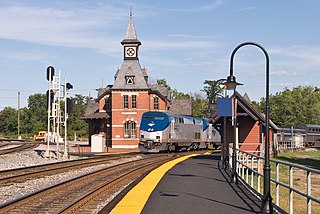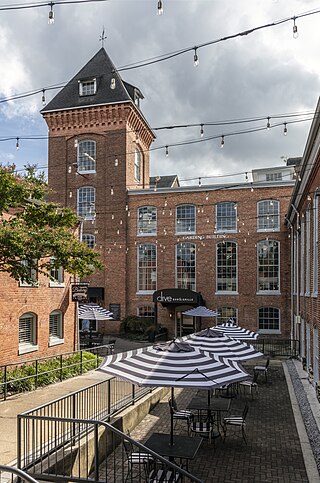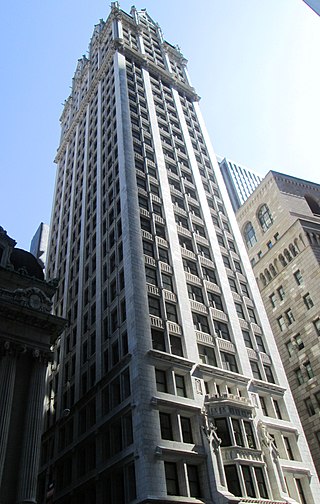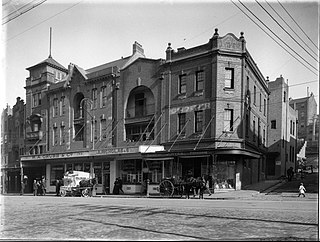
The Historic Third Ward is a historic warehouse district located in downtown Milwaukee, Wisconsin. This Milwaukee neighborhood is listed on the National Register of Historic Places. Today, the Third Ward is home to over 450 businesses and maintains a strong position within the retail and professional service community in Milwaukee as a showcase of a mixed-use district. The neighborhood's renaissance is anchored by many specialty shops, restaurants, art galleries and theatre groups, creative businesses and condos. It is home to the Milwaukee Institute of Art and Design (MIAD), and the Broadway Theatre Center. The Ward is adjacent to the Henry Maier Festival Park, home to Summerfest. The neighborhood is bounded by the Milwaukee River to the west and south, E. Clybourn Street to the north, and Lake Michigan to the east.

Ephraim Francis Baldwin was an American architect, best known for his work for the Baltimore and Ohio Railroad and for the Roman Catholic Church.

The Savage Mill is a historic cotton mill complex in Savage, Maryland, which has been turned into a complex of shops and restaurants. It was placed on the National Register of Historic Places in 1974. It is located in the Savage Mill Historic District. Buildings in the complex date from 1822 to 1916.

The Worcester Bleach and Dye Works is a historic factory complex at 60 Fremont Street in Worcester, Massachusetts. It consists of a pair of primarily brick factory buildings, one of which was built in 1909, and the other built later, between 1911 and 1922, for the named company, which was a major local manufacturer of thread. After the Bleach and Dye Works closed its doors in 1938, the complex has seen a succession of other owners.

Cumberland station is a historic railway station in Cumberland, Allegany County, Maryland. It was built in 1913 as a stop for the Western Maryland Railway (WM). The building was operated as a passenger station until the WM ended service in 1959, and it continued to be used by the railway until 1976. It was subsequently restored and currently serves as a museum and offices, as well as the operating base for a heritage railway.

The Jefferson–Chalmers Historic Business District is a neighborhood located on East Jefferson Avenue between Eastlawn Street and Alter Road in Detroit, Michigan. The district is the only continuously intact commercial district remaining along East Jefferson Avenue, and was listed on the National Register of Historic Places in 2004.

Londontown Manufacturing Company, Inc., also known earlier as the Meadow Mill of the old Woodberry Manufacturing Company is a historic cotton mill industrial complex located at Baltimore, Maryland, United States. It is a four-story, Italianate red brick structure that features a square tower structure with a truncated spire-like roof having an open bell tower cupola. It sits on the west bank of the Jones Falls stream which runs north to south, parallel to the elevated Jones Falls Expressway.

Coca-Cola Baltimore Branch Factory is a historic factory complex located at Baltimore, Maryland, United States. It was constructed from 1921 to 1948 and built principally to house Coca-Cola's syrup-making operations. The complex is spread over a 9.4-acre (38,000 m2) site and includes a two-story brick syrup factory/sugar warehouse and an earlier two-story brick mattress factory that Coca-Cola acquired and adapted in the 1930s. Completed in 1948, the complex housed syrup-making operations as well as the Coca-Cola Company's chemistry department.

Montgomery Ward Warehouse and Retail Store is a historic warehouse and retail building in Baltimore, Maryland, United States. It is an eight-story concrete structure and is roughly shaped like a squared-off number "4". The front features a penthouse tower at the main entrance bay with a balcony and capped by a flagpole. The building houses over 1,200,000 square feet (110,000 m2) of floor space flooded by light from approximately 1,000 large multi-paned, steel frame windows. It was built about 1925 as a mail order and retail warehouse for Montgomery Ward on an 11 acres (4.5 ha) site adjacent to the Baltimore and Ohio Railroad tracks. The complex was one of nine large warehouses built by the company in the United States.

The Liberty Tower, formerly the Sinclair Oil Building, is a 33-story residential building in the Financial District of Manhattan in New York City. It is at 55 Liberty Street at the northwest corner with Nassau Street. It was built in 1909–10 as a commercial office building and was designed by Henry Ives Cobb in a Gothic Revival style.

Buchanan County Court House in Independence, Iowa, United States was built in 1940. It was listed on the National Register of Historic Places in 2003 as a part of the PWA-Era County Courthouses of IA Multiple Properties Submission. The current structure is the third courthouse to house court functions and county administration.

The Dry Dock Complex consists of six interconnected buildings located at 1801–1803 Atwater Street in Detroit, Michigan, as well as the remains of a nearby dry dock at 1900 Atwater Street. The 1801-1803 Atwater complex is also known as the Globe Trading Company Building, and in 2015 was opened by the Michigan Department of Natural Resources as the Outdoor Adventure Center.

The Michigan Bell and Western Electric Warehouse is a former commercial warehouse building located at 882 Oakman Boulevard in Detroit, Michigan. It was listed on the National Register of Historic Places in 2009. It is now known as the NSO Bell Building.

The Lima Cleaning and Pressing Company Building is a historic structure located along South Main Street in Lima, Ohio, United States. Built in 1890, it is an example of an early style of commercial architecture.

The Simmons Hardware Company Warehouse, also known as the Battery Building, is a historic warehouse located in Sioux City, Iowa that is on the National Register of Historic Places. The six-story building covered a whole block and its construction was supervised by Frank Bunker Gilbreth, Sr., the time and motion study pioneer.

The Bellows Falls Co-operative Creamery Complex is a historic industrial property in Bellows Falls, Vermont. Developed over a period of about 40 years beginning c. 1906, the complex, with two surviving buildings, it represents one of Vermont's largest commercial enterprises of the period. The property, located on the eastern side of Bellows Falls Island, was listed on the National Register of Historic Places in 1990.

The former Albany Felt Company Complex, now The Lofts at One Broadway, is located along Broadway in eastern Albany County, New York, United States. It is mostly within the village of Menands, with a small portion at its southern end within the city of Albany. In 2014 it was listed on the National Register of Historic Places.

The Iowa Wind Mill and Pump Company Office and Warehouse, also known as Iowa Pipe and Supply Company, Cedar Rapids Presort, and the Mott Building, is a historic building located in Cedar Rapids, Iowa, United States. This is the only extant building of a complex of buildings along the Cedar River used by the Iowa Wind Mill and Pump Company. The three-story structure is a simplified version of Victorian architecture. The thick brick walls were a form of fire protection and insulation, while the heavy timber for the interior support structure created large open space that was required to house industrial equipment, production activities, and warehouse storage. The tall windows allowed for interior lighting and ventilation. The first floor provided finished space used for offices. Iowa Wind Mill and Pump Company began as a branch of the Kendallville, Indiana based Flint & Walling Manufacturing Company around 1890. They began building their complex of buildings along the Cedar River and the tracks of the Chicago and North Western Railroad the following year. This building was completed in 1902. It was listed on the National Register of Historic Places in 2012.

Lawson House is a heritage-listed warehouse, auction house and offices located at 212–218 Cumberland Street, in the inner city Sydney suburb of The Rocks in the City of Sydney local government area of New South Wales, Australia. It was designed by John Burcham Clamp and built during 1924 by Burcham Clamp and Finch. It is also known as Cadbury-Fry Building and Lawson Menzies Building. The property is owned by Property NSW, an agency of the Government of New South Wales. It was added to the New South Wales State Heritage Register on 10 May 2002.

145 George Street, The Rocks is a heritage-listed duty-free store complex and former retail building and residence located at 145 George Street, in the inner city Sydney suburb of The Rocks in the City of Sydney local government area of New South Wales, Australia. It was built in 1892. It is also known as Currently part of Duty Free Store complex. The property is owned by Property NSW, an agency of the Government of New South Wales. It was added to the New South Wales State Heritage Register on 10 May 2002.
























